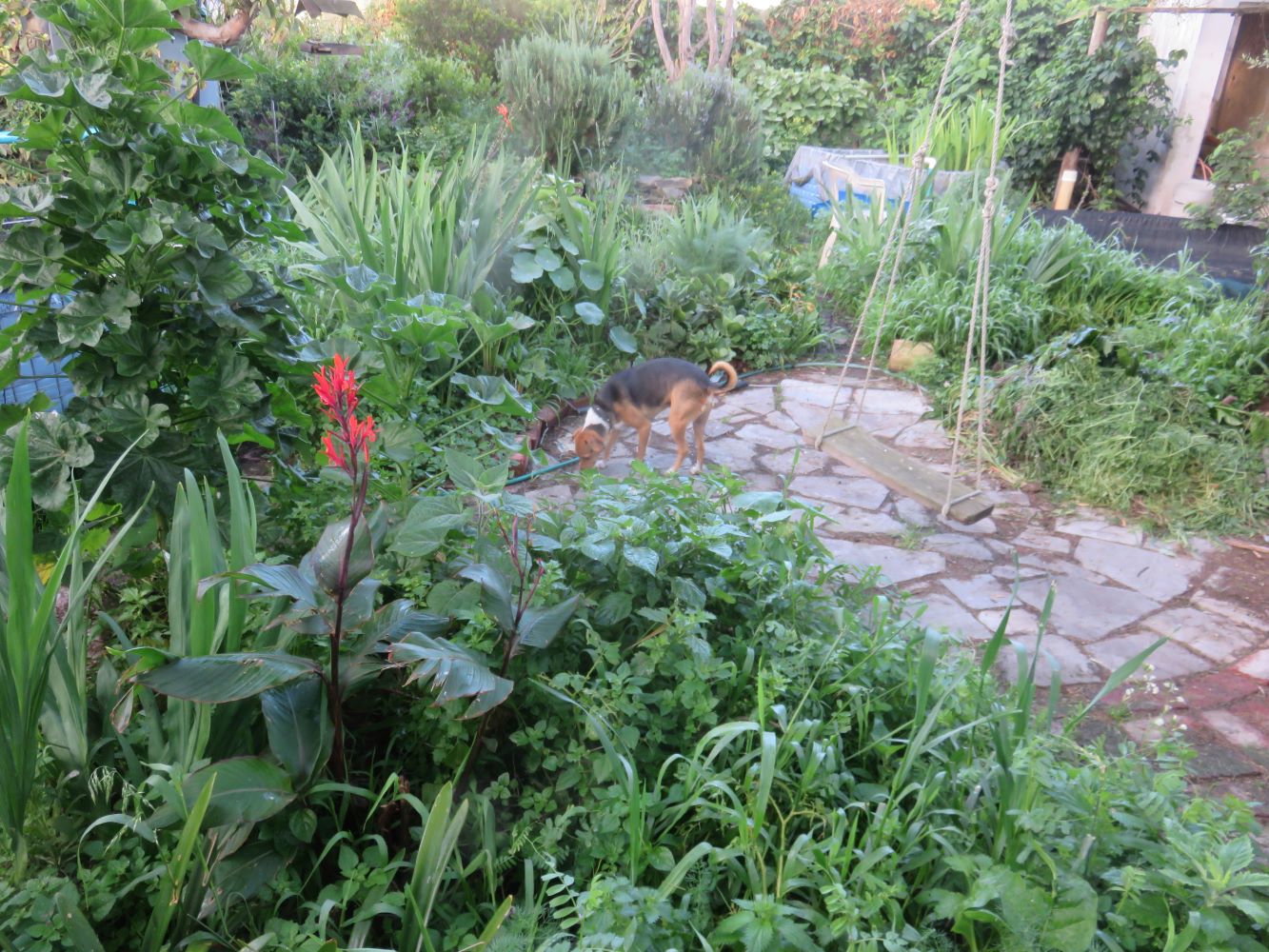Dear Reader, in this age of AI created content, please support with your goodwill someone who works harder to provide the human-made. Sign up in the righthand column or bottom of this page. You will receive my hand illustrated monthly newsletter RESTORE NATURE and access to the biodiversity garden design course as I write...and nothing else, I respect your time.
Winter crops in a Mediterranean climate
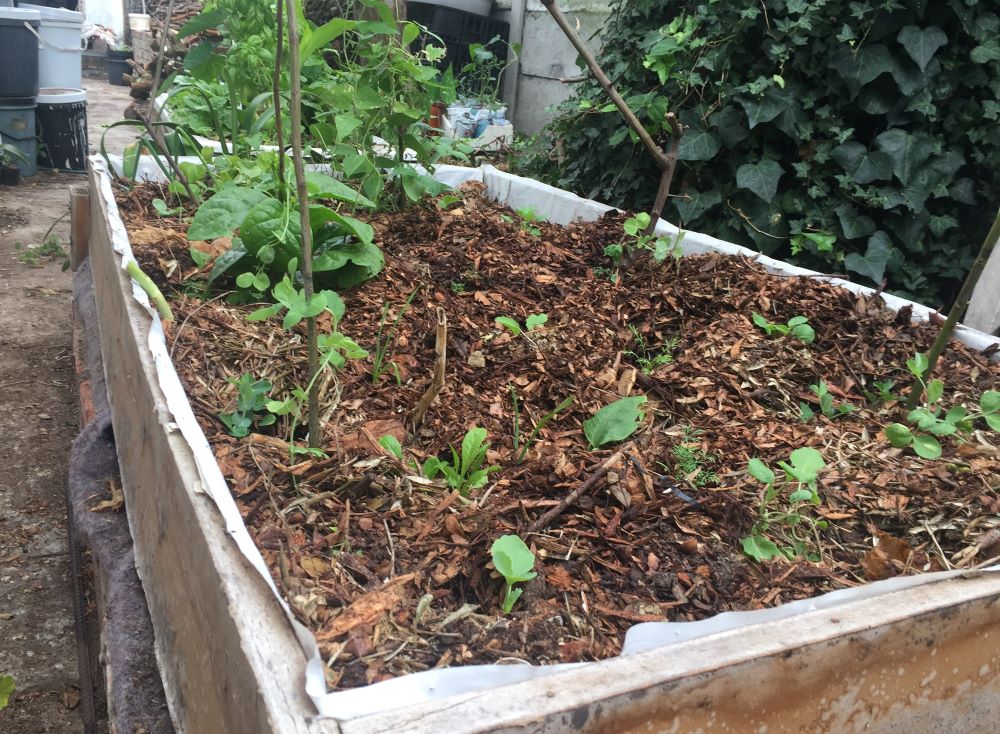
We are blessed by having a winter growing season. The Mediterranean climate zones cover only 3 percent of the earth's surface. Despite the small area, the European Mediterranean zone, after which this climate type is named, was prominent in the history of agriculture. It is the origin of many vegetables such as cabbage, broccoli, kale, collard greens, celery, peas, artichokes, cardoons, asparagus, lettuce, arugula, beets, chard, turnips and more.
But all Mediterranean zones are not alike. At the Cape we have one of the most diverse floras in the world, and yet it has yielded few vegetables. Strangely our decorative plants have become foundational to many gardens around the world as we provided Pelargoniums, Agapanthus, Zantedeschia, Gladiolus and many others. I believe this is not due to lack of edible candidates, as the nomadic people of the Cape used at least 200 of our plants for food. Rather the nature of colonialism caused our flowers to gain admiration and our local food plants to be rejected by colonists. Its an interesting question as to why. Our physical location and drier, warmer climate may also play a part in making our food plants less enticing.
Not only does the European Mediterranean have much higher rainfall than the Western Cape in South Africa, our soils are globally renowned for being nutrient poor. This article will deal with the challenge of choosing winter crops, and some soil amelioration that is needed to grow mainly 'European' vegetables here in this region.
Winter crops as part of a twice yearly sowing regime
Struggle leads to adaptation. For me growing annual vegetables has been a struggle ! This article is about the second bout, the winter crops in a trial of twice yearly vegetable planting, spring and autumn.
I wonder how many other would be food growers have this experience, because one of the biggest issues for me was the sheer cognitive load imposed by having to know when to sow each plant at the right time of year. Local gardeners make light of it and are sowing seeds almost on a fortnightly basis. I don’t know if their long years of experience have wiped away memory of the mental effort, or if they want to intimidate newbies with their smarts ! I messed up planting times for years and then got serious. This new seriousness started with a decision to only plant one new vegetable a year so that I could ‘learn’ them ‘properly’. Soon this seemed terribly limiting. My second idea was to sow only once a year. This also limited the choice a bit, excluding the vegetables that don't like our hot dry summers. I settled on twice yearly. The overlaps in the complex array of planting times when you have year round growing allowed me to choose this optimum, as I explain in the first article which is on summer vegetables.
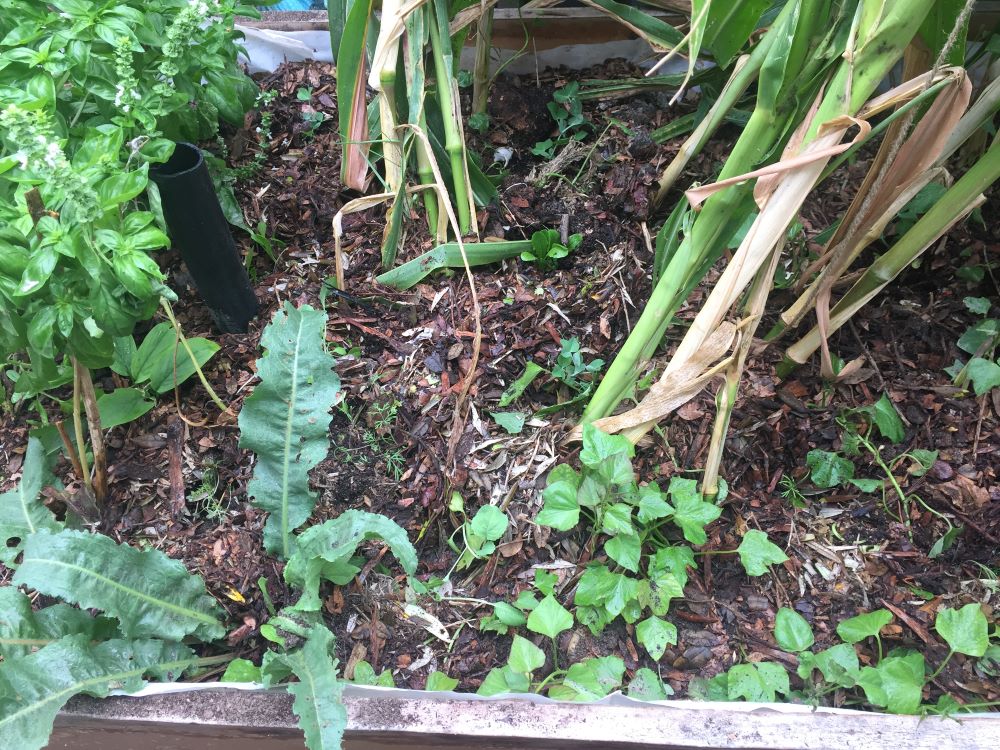 interplanting under summer crops. You can just see some dill and cabbage seedlings between the maize stalks.
interplanting under summer crops. You can just see some dill and cabbage seedlings between the maize stalks.Experimental conditions
So on with the laboratory hat (do people in laboratories wear hats ?). My lab coat is my sweat stained working attire, and the garden my lab. The hat is a thing I hacked together on my grandmas sewing machine for garden work. In it I look more like a 17th century peasant, or a witch, than a scientist, so must perforce acquiesce to this identity imposed by my appearance. Witches rely on ritual, intuition, observation and for the good ones, plenty of benevolence towards all creatures great and small. For me this works better than hard science.
Choosing winter crops for our region
Our winter is probably more similar to a British summer. This means that although we don’t have a long season in which nothing can grow, we also have to be very careful about when and where to plant. It can’t all go in the ground after the last frost in full sun. We don’t have frost, our full sun can be a killer, and our soil is so poor that compost doesn't really do much for it, and to grow vegetables without chemicals is a challenge.
We have to read between the lines of European or north American gardening manuals and decipher which vegetables really like the heat, and which will curl up their toes when planted in South African summer conditions. Separating vegetables into true sun lovers, and those which are OK with our winters and dislike dry weather and baking heat, is what needs to be done, and the manuals aren’t helpful. Even our own vegetable gardening books are sometimes cut and pasted from northern hemisphere writing and following their instructions doesn’t really work.
Our winter vegetables are things like brassicas and dill. Our lettuces need semi shade or they just scorch. If the winter vegetables are planted too late, the cold weather keeps them from growing, the trays get full of weeds and the measly plants planted out when summer comes just succumb to herbivorous things of all sizes or bolt after a week or two. The winter vegetables need to get going before the cold comes in June and July. I hope I’m finally getting my stuff in a row here.
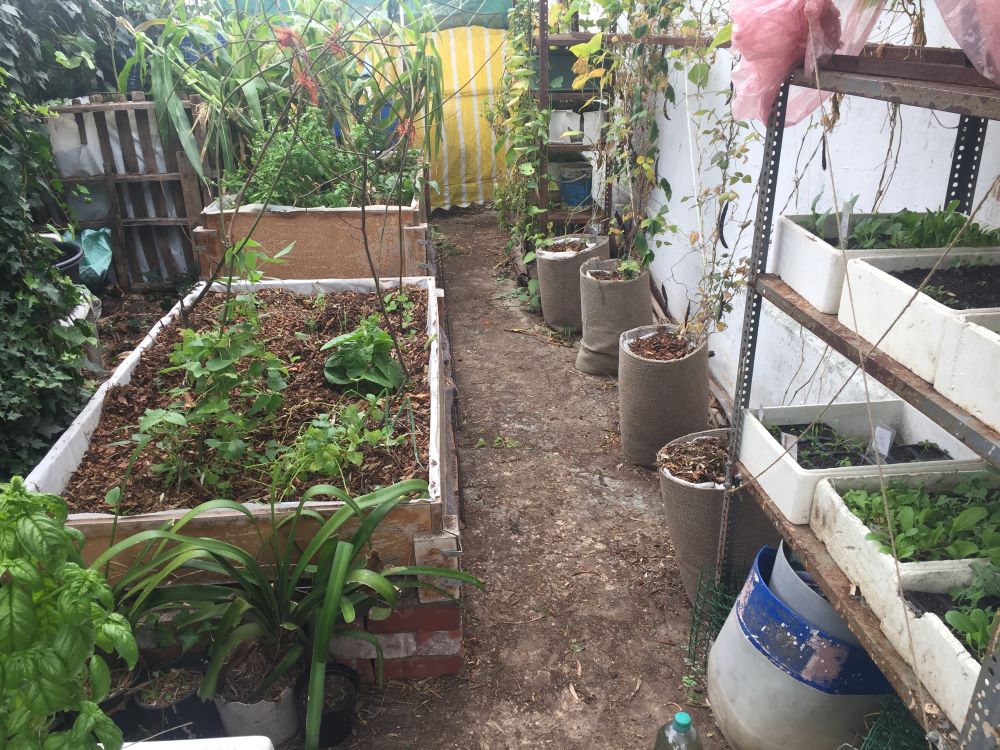
My MO for sowing, and this year's choice of winter crops and germination
The seeds were sown in six-packs in poly-styrene trays in my vertical greenhouse made from an old steel shelf covered with transparent plastic. The shelf accommodates 9 trays, so that I sow 9 vegetables in each of my sowing seasons, and each tray has 4 six-packs, therefore 24 plants or groups of seedlings for each vegetable.
Each set of seeds is labeled with a toothpick holding up a tiny plastic bag into which a paper label with a ball point pen description is inserted. I've tried a lot of labeling experiments and none work for me, as the writing fades. With this method the writing lasts just long enough so that I know if there has been a fail and I can discard the tray.
This year I’ve sown peas, cos lettuce, butter lettuce, curly kale, savoy cabbage, dill, mizuna (spider mustard), mustard, Italian dandelion and our local dune spinach (Tetragonia decumbens). I’ve planted out cultured sweet potato vines and sprouted tubers as ground cover.
The soil mix was half sand and half compost, including a little humanure and vermicast and a lot of fine acacia leaves which act as a kind of ‘peat moss’ being highly water retentive, and releasing nitrogen as they decompose. This soil mix is enough to get the plants germinated and to the four leaf stage before the trouble with infertility starts. I have found vermicast helps with wilting off.
All seeds germinated very well except the butter lettuce which did not germinate, some old seeds that didn’t come, and the dune spinach, of which only two seeds have come up. These Tetragonia seeds were gathered at the beach and they were spotted with black mold, so I was expecting problems.
Planting out our winter crops
The germinated seeds grew into small plants and I planted half of them out at the 4 leaf stage. Some thing, definitely a mollusc, has been visiting at night and leaving me with naked green stalks, but so far only about 5% have succumbed (later update, nearly all brassicas have succumbed). I go out an hour before sunrise and an hour after sunset with a torch, but have found nothing thus far. I’m worried the plants are still too tender, and I’m growing the rest of the seedlings on to a larger size in the green house (now open sided after rolling up the plastic). I will wait two weeks for the first planting to take and the second batch to grow larger and then plant the second lot. Will try traps tomorrow.
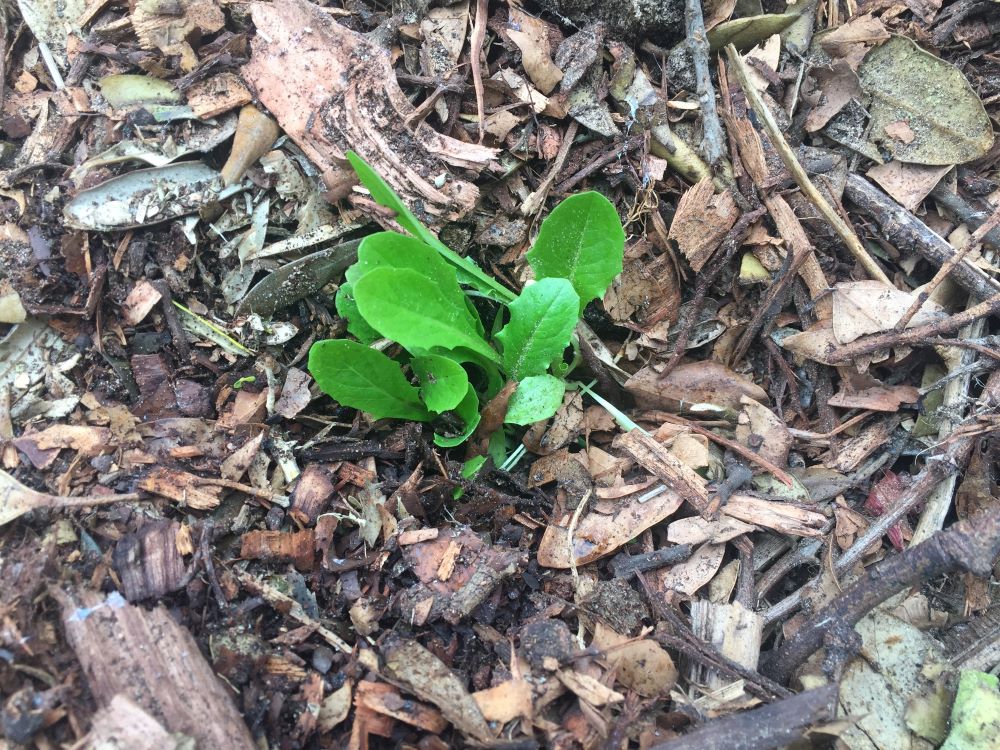 Cos lettuce seedlings mulched with wood chips.
Cos lettuce seedlings mulched with wood chips.Enriching and building our notoriously poor sandy soils.
The beds are deeply
mulched with wood chips from Ficus and Meterosideros logs. I’ve
heard straw is better for vegetables but this is all I have. The
mulch seems to be keeping the seedlings nicely moist. I’m building
up a large quantity of mulch from our Vichellia karoo (sweet thorn)
and I’m hoping that this can be used to mulch vegetables in the
future as it must have a higher nitrogen content. Vichellia being a
legume and nitrogen fixer.
Soil has been another issue contributing to struggle. Our soils are globally poor, resulting from the weathering of very ancient rocks, soils exposed for so long that all that is left is silica granules, or pure sand. Most of Cape Town was under the sea in recent geological time, and our soil on the flat land between the ancient mountains consists of wind blown sea sand and shell dust.
95% of my garden work is
processing biomass for the sake of our soil: cutting up trimmed tree
branches and shredding thorny twigs to make safe walk-able mulch
being the bulk of this work. I wish there was a shortcut. I’ve
tried many that sort of work, but I'm still looking for the ideal solution.
I sometimes leave thorny twigs to oxidize under trees in less used corners of the garden till they are so brittle I can flatten them with my army boots. I also make biochar, and use the wood for the clay oven, and for making a fire for tea when we have power cuts, which have become a way of life in South Africa.
Managing a bucket system for humanure, and a separate bucket system for kitchen waste recycled through vermiculture take up a very small amount of time in comparison, but are vital elements of vegetable growing too.
But all this organic matter in the soil does not help in a region with such low mineral content in the soil. Therefore some natural supplementation must be used. I brew kelp and also add it to the beds when I build them. Bone meal and rock dust is scattered on the beds twice a year, and added to plant based teas. Our humanure may contain minerals from outside the garden ecosystem, so perhaps that helps. Bones in mesh bags are added to the urine fermentation tank.
Plant teas, fresh and really ripe, as well as ash from burning our dry thorn branches are added. But I think that anything made from our own plants may have the same poverty of minerals. I've noticed that adding externally acquired minerals has helped with growing demanding European vegetables and given me success for the first time.
However, some plants mine minerals from the soil and these can help concentrate minerals above ground. Comfrey, the usual permaculture stalwart just doesn't ever thrive in my garden. I therefore am very friendly to the weeds that come up because they have either evolved to do with less of certain minerals, or they can mine them.
Pulling up a certain weed I had come to hate as it is so successful at survival and its everywhere, I noticed how dense the soil accretions were around it's roots. They cannot be shaken off as is the case with most plants. It must be a soil builder, so I've gone from hostility to appreciation, from trying to eradicate it, to leaving it be unless its in the way.
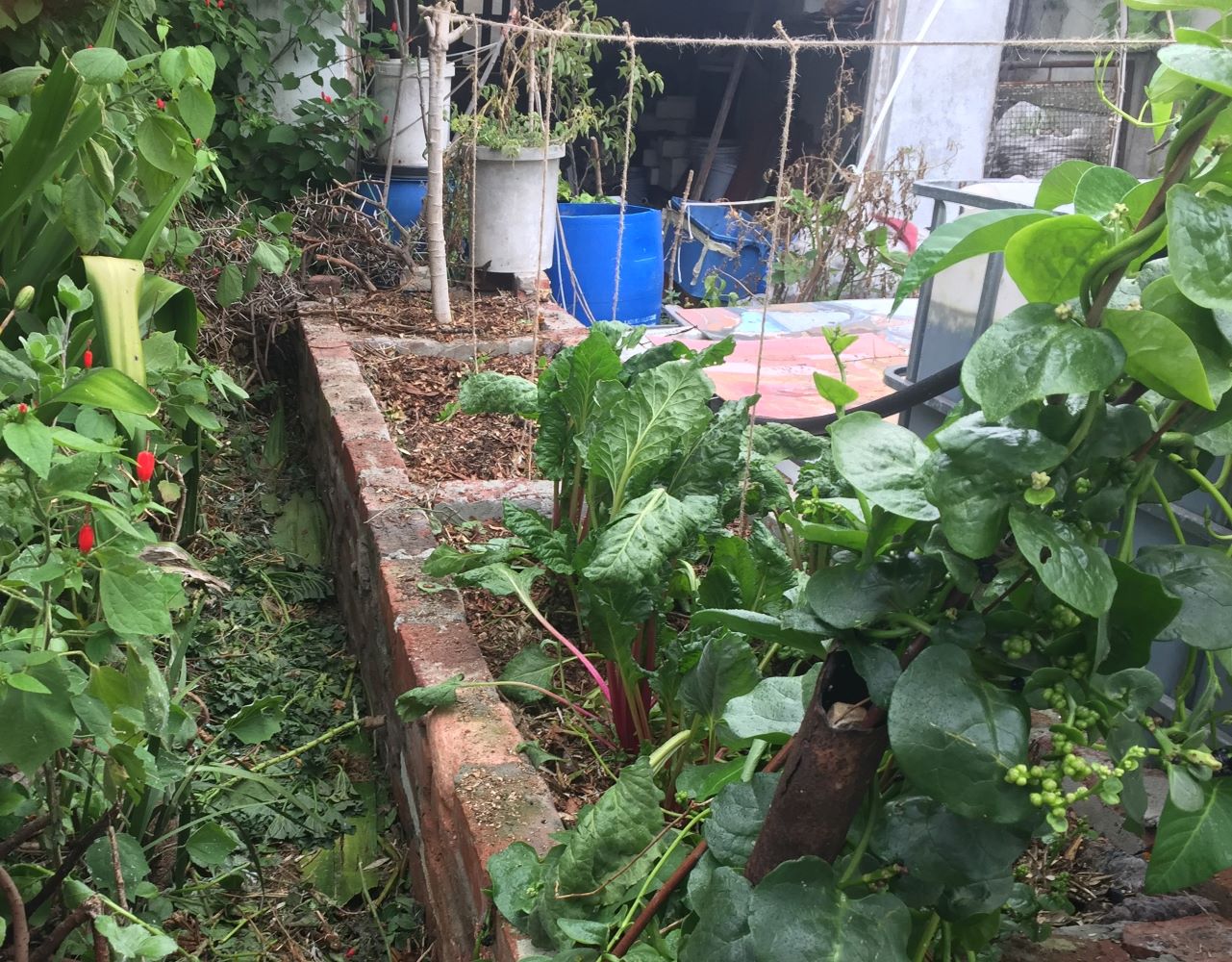
Water and our crops
Water is a vital ingredient in fertility as its the basis of life, not only feeding the plants but supporting more soil organisms. My own checks under the microscope showed that the dry areas of the garden were free of visible life whereas the sealed grey-water beds which are damp below the surface were teaming with a great variety of worms, flagellates, mycelium, small arthropods and very strange and beautiful protozoa. In other words, all the forms of life one needs in soil.
Water supply was of course problematic in summer, but in winter it rains often enough that watering with a can is only on demand and much less often and our winter crops generally thrive on the rain.
Just in case you are pitying me for not installing irrigation, I relish this activity with the watering can as dipping into the rain tanks and lifting the 10 liters of water out with a whoosh helps maintain my upper body strength, and gym can be a real time waster.
On that cheerful note I hope to add to this article as the season progressed and we finally harvest.
home page with links to topics on natural gardening, biodiversity and food growing
Restore Nature Newsletter
I've been writing for four years now and I would love to hear from you
Please let me know if you have any questions, comments or stories to share on gardening, permaculture, regenerative agriculture, food forests, natural gardening, do nothing gardening, observations about pests and diseases, foraging, dealing with and using weeds constructively, composting and going offgrid.
Your second block of text...
SEARCH
Order the Kindle E-book for the SPECIAL PRICE of only
Prices valid till 30.09.2023
Recent Articles
-
garden for life is a blog about saving the earth one garden at a time
Apr 18, 25 01:18 PM
The garden for life blog has short articles on gardening for biodiversity with native plants and regenerating soil for climate amelioration and nutritious food -
Cape Flats Sand Fynbos, Cape Town's most endangered native vegetation!
Apr 18, 25 10:36 AM
Cape Flats Sand Fynbos, a vegetation type found in the super diverse Cape Fynbos region is threatened by Cape Town's urban development and invasive alien plants -
Geography Research Task
Jan 31, 25 11:37 PM
To whom it may concern My name is Tanyaradzwa Madziwa and I am a matric student at Springfield Convent School. As part of our geography syllabus for this
"How to start a profitable worm business on a shoestring budget
Order a printed copy from "Amazon" at the SPECIAL PRICE of only
or a digital version from the "Kindle" store at the SPECIAL PRICE of only
Prices valid till 30.09.2023

